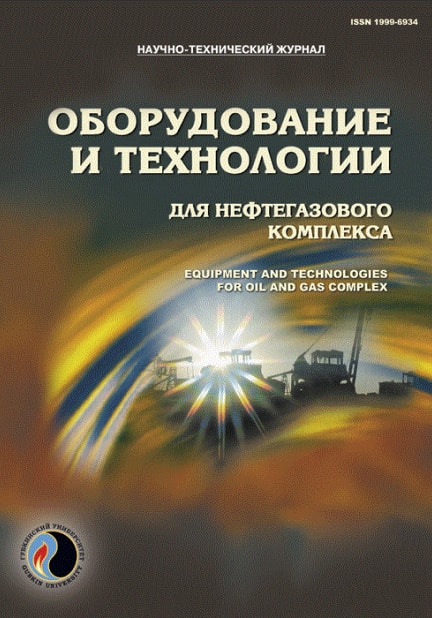Scientific and technical journal
«Equipment and technologies for oil and gas complex»
ISSN 1999-6934

Dependence of oil emulsion viscosity on particle and water concentration
UDC: 665.61
DOI: 10.33285/1999-6934-2023-6(138)-24-28
Authors:
1 Institute of Catalysis and Inorganic Chemistry of ANAS, Baku, Azerbaijan
2 Azerbaijan State Oil and Industry University, Baku, Azerbaijan
Keywords: oil disperse system, rheology, viscosity, particle, structure formation, coagulation
Annotation:
It has been shown that dynamic viscosity plays a key role in structured petroleum dispersed systems, determining their rheological properties. Particles concentration growth increases the effective viscosity linearly if the particles of the dispersed phase are located at significant distances from each other, thus reducing the probability of their intermolecular interaction. There are a number of empirical formulas for calculating the dispersed media viscosity. However, the choice of the model is based on the adequate description of experimental data, and not on the of structure formation mechanism. It is important to note that development of a general rheological equation for different systems is considered impossible. The particles size increase leads to the effective viscosity increase, at which coagulation structures and aggregates are not formed, but there occurs dense packing of the particles. This happens due to the fact that the presence of dispersed phase particles distorts the fluid flow near these particles, which affects the viscosity of the dispersed system. The small concentration of particles eliminates collisions, and the flow of fluid near one of the particles affects the flow of fluid around the other ones. The above-said confirms the fact that the effective viscosity of a disperse system is strongly dependent on the volume fraction and particle size. The viscosity and, accordingly, the rheological properties of the emulsion are equally influenced by the presence of deformable drops and bubbles in it, and their high concentration, at which coagulation structures called flocculi are formed. Calculations of the dependence of the oil emulsion viscosity on the water content in the volume and shear stress are shown, demonstrating the change of the emulsion viscosity.
Bibliography:
1. Khodakov G.S. Reologiya suspenziy. Teoriya fazovogo techeniya i ee eksperimental'noe obosnovanie // Ros. khim. zhurn. – 2003. – T. XLVII, № 2. – S. 33–44.2. Mekhanika i reologiya neftyanykh dispersnykh sistem / G.I. Kelbaliev, S.R. Rasulov, D.B. Tagiev, G.R. Mustafaeva. – M.: Maska, 2017. – 462 s.
3. Kelbaliyev G.I., Tagiyev L.B., Rasulov S.R. Transport Phenomena in Dispersed Media. – Boca Raton, FL, USA: CRC Press, 2019. – 456 p.
4. Vielma J.C. Rheological Behavior of Oil-Water Dispersion Flow in Horizontal Pipes: A Thesis for the Degree of Master of Science in the Discipline of Petroleum Engineering. – The University of Tulsa, 2006. – 107 p.
5. Kelbaliev G.I., Rasulov S.R., Mustafaeva G.R. Viscosity of Structured Disperse Systems // Theoretical Foundations of Chemical Engineering. – 2018. – Vol. 52, Issue 3. – P. 404–411. – DOI: 10.1134/S0040579518020082
6. Droplet Dynamics of Newtonian and Inelastic Non-Newtonian Fluids in Confinement / N. Ioannou, Haihu Liu, M.S.N. Oliveira, Yonghao Zhang // Micromachines. – 2017. – Vol. 8, Issue 2. – P. 57. – DOI: 10.3390/mi8020057
7. Blanchette F., Bigioni T.P. Dynamics of drop coalescence at fluid interfaces // J. of Fluid Mechanics. – 2009. – Vol. 620. – P. 333–352. – DOI: 10.1017/S0022112008004801
8. Brounshteyn B.I., Shchegolev V.V. Gidrodinamika, masso- i teploobmen v kolonnykh apparatakh. – L.: Khimiya, 1988. – 336 s.
9. An overview of heavy oil properties and its recovery and transportation methods / R.G. Santos, W. Loh, A.C. Bannwart, O.V. Trevisan // Brazilian J. of Chemical Engineering. – 2014. – Vol. 31, Issue 03. – P. 571–590. – DOI: 10.1590/0104-6632.20140313s00001853
10. Zlobin A.A., Yushkov I.R. O mekhanizme strukturoobrazovaniya neftyanykh dispersnykh sistem // Vestn. Permskogo gos. tekhn. un-ta. Geologiya. Neftegazovoe i gornoe delo. – 2008. – T. 7, № 3. – S. 13–20.
11. Ermakov S.A., Mordvinov A.A. O vliyanii asfal'tenov na ustoychivost' vodoneftyanykh emul'siy // Elektron. nauch. zhurn. Neftegazovoe delo. – 2007. – № 1. – S. 59.
12. Experimental investigation of non-Newtonian droplet collisions: the role of extensional viscosity / G. Finotello, Sh. De, J.C.R. Vrouwenvelder [et al.] // Experiments in Fluids. – 2018. – Vol. 59, Issue 7. – P. 113. – DOI: 10.1007/s00348-018-2568-2
13. Dissolution of Asphaltene in Binary Mixtures of Organic Solvents and Model Maltenes: Unambiguous Evidence for Asphaltene Preferential Solvation and Relevance to Assessing the Efficiency of Additives for Asphaltene Stabilization / L.P. Novaki, N. Keppeler, M.M.N. Kwon [et al.] // Energy & Fuels. – 2019. – Vol. 33, Issue 1. – P. 58–67. – DOI: 10.1021/acs.energyfuels.8b02892
14. Shear-induced sedimentation in yield stress fluids / G. Ovarlez, F. Bertrand, Ph. Coussot, X. Chateau // J. of Non-Newtonian Fluid Mechanics. – 2012. – Vol. 177–178. – P. 19–28. – DOI: 10.1016/j.jnnfm.2012.03.013
15. Osazhdenie chastits v nen'yutonovskoy nefti / G.I. Kelbaliev, S.R. Rasulov, M.R. Manafov, F.R. Shykhyeva // Oborudovanie i tekhnologii dlya neftegazovogo kompleksa. – 2022. – № 2(128). – S. 45–51. – DOI: 10.33285/1999-6934-2022-2(128)-45-51